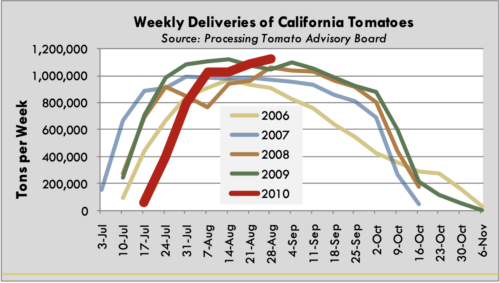 May and June were not kind to California’s tomato crop. Winter‐like temperatures and late rainfall delayed transplanting and slowed the development of seedlings.
May and June were not kind to California’s tomato crop. Winter‐like temperatures and late rainfall delayed transplanting and slowed the development of seedlings.
As a result, harvesting began about two weeks behind schedule. Harvesters didn’t enter the fields in the northern areas until almost August.
Tomatoes planted for delivery in the early part of the season were hit the worst. The cool, damp spring proved a hospitable environment for bacterial disease. Pressure from disease caused the plants to drop foliage and struggle to set their crowns.
By the end of August, harvesters worked through the difficult fields at the beginning of the crop and now growers are find‐ ing excellent stands in their fields. Moderate summer temperatures have allowed later season tomatoes to develop and yields are near expectations.
Despite its late start, the season will end near the same time as in past years. To decrease the pack size, processers had planned to finish about two weeks earlier than normal. Instead the season was shortened on the front end, instead of the back. California’s late crop has been strong the last several years.
VOLUME EXPECTED
Officially, California’s 2010 crop expectations are only 7.5% below last year’s bumper crop. The May release of California Processing Tomato Report fore‐ casts 12.3 million ton crop.
But with only 269,000 acres contracted, an unlikely record yield of 46 tons per acre is required to meet that volume. Given the disease pressure and a poor start, the crop is more likely to average 40 tons per acre. This would bring in a crop closer to 11 million tons.
TOMATO PRICE SETTLED
While the first harvesters were entering the fields in mid‐July, the California Tomato Growers Association and processors finally agreed to a field price of $65 tons per acre. The drop is 18.7% below last year’s record price of $80 per ton. It’s the first price drop growers have taken since 2005.

Morning Star Newsletter now distributed electronically
As a reminder, Morning Star is now distributing our newsletters electronically using an email distribution vendor called Mailchimp. Your e-version will now include informative Morning Star videos and highlights. Depending on your company's firewall, these emails may initially be directed to you spam folder.

